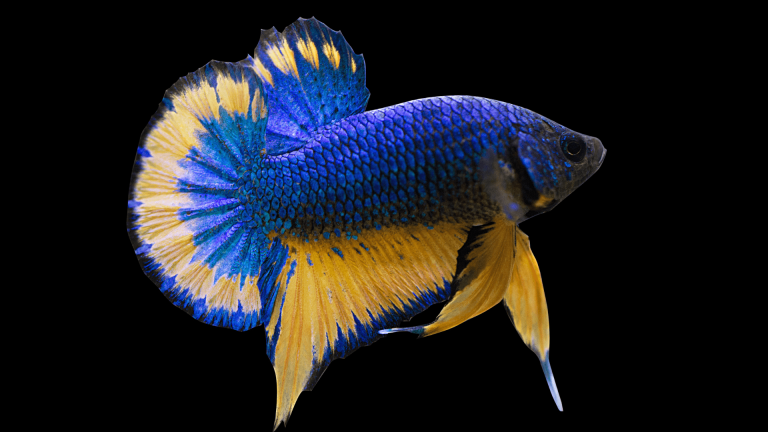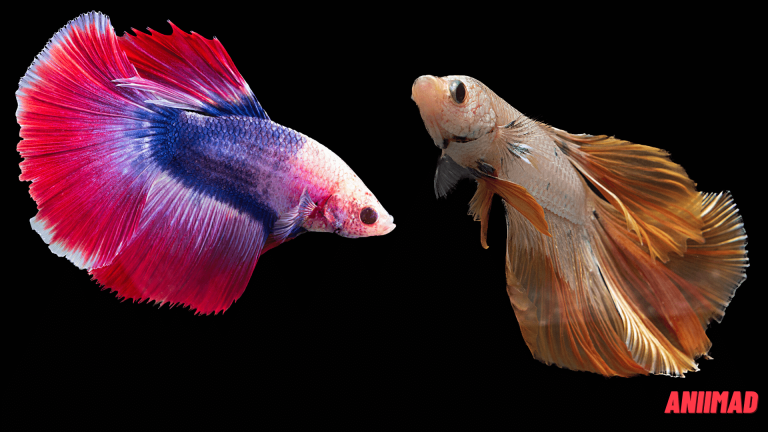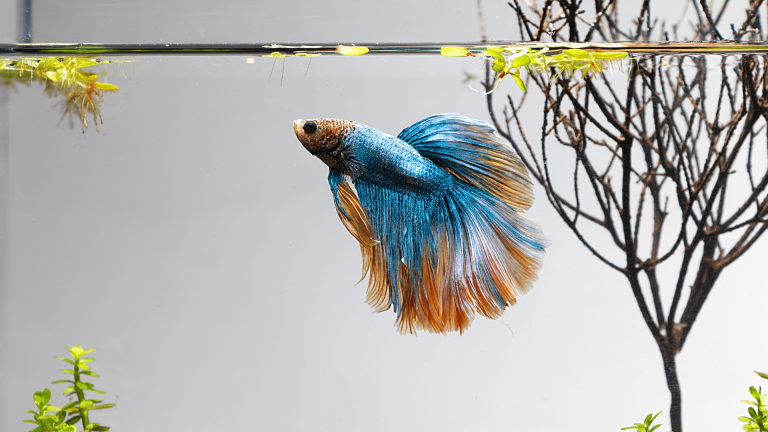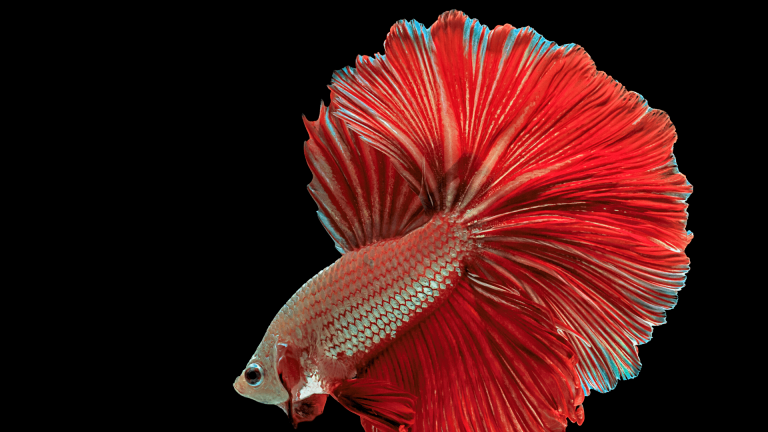Understanding Betta Fish Fight: A Comprehensive Guide
Contents
- 1 How do a Betta Fish Fight?
- 2 How Do You Know If Your Betta Fish Are Fighting?
- 3 Should I Let My Betta Fish Fight?
- 4 Do Male And Female Betta Fish Fight
- 5 Can You Put Two Female Bettas to Gether?
- 6 Do Betta Fish Fight to Death?
- 7 Do Bettas Fight Other Fish?
- 8 How to Avoid Fighting in Your Betta Fish Tank
- 9 Here are Some Frequently Asked Questions About Betta Fish Fight
- 9.1 Do all betta fish fight?
- 9.2 Can female betta fish fight?
- 9.3 Can you keep male and female betta fish together?
- 9.4 Can betta fish fight to Death?
- 9.5 How can I prevent fighting in my betta tank?
- 9.6 What are the signs of betta fish fighting?
- 9.7 Can betta fish live peacefully with other fish?
- 9.8 Should I separate fighting betta fish?
- 9.9 Can betta fish fight in a divided tank?
- 9.10 Can betta fish fight through the tank glass?
- 10 Conclusion
Siamese fighting fish, often known as betta fish, are stunning, colorful aquatic creatures that have caught the interest of fish fans worldwide. While admired for their striking colors and elaborate fins, betta fish are notorious for their territorial nature and aggressive Behavior, often engaging in fights with other bettas. In this article, we will delve into the world of betta fish fights, exploring the reasons behind their aggression and providing insights on managing and preventing these conflicts.
How do a Betta Fish Fight?

When betta fish engage in fights, their aggressive Behavior is fascinating. Here’s a description of how betta fish fight:
01. Displaying Aggressive Postures
Before physical contact, betta fish often use aggressive postures to intimidate opponents. They would puff out their bodies, stretch their fins, and flare their gills to appear more significant and dangerous.
02. Flaring
Flaring is unusual in which betta fish extend their fins and gill covers, creating an impressive display. They are open to making themselves look more intimidating and asserting dominance over their opponent. Flaring also serves to make their bodies appear larger.
03. Nipping and Biting
Once the betta fish have established dominance through displays and flaring, they may engage in physical combat. Nipping and biting are common aggressive behaviors during fights. Betta fish have small but sharp teeth that they use to bite and attack their opponent.
04. Tail-Slapping
Another behavior seen in betta fish fights is tail-slapping. It occurs when a betta fish forcefully slaps its opponent with its tail, aiming to cause damage and assert dominance. Tail-slapping can lead to torn fins or other injuries if the fight intensifies.
05. Charging and Circling
Betta fish often charge at each other during fights, attempting to make physical contact. They may circle each other, darting in and out to strike and defend. This Behavior showcases their agility and speed.
06. Retreat and Submission
A betta fish may sometimes retreat or submit during the fight. It is an acknowledgment of defeat and a sign that the war is over. The submissive fish may display subdued colors and try to swim away or hide to avoid further confrontation.
It is important to note that betta fish fights can be extremely stressful and harmful to the fish involved. Keeping betta fish in separate enclosures is the best way to prevent wars and ensure their well-being. Introducing tankmates should be done with caution and careful observation to avoid any aggressive interactions.
How Do You Know If Your Betta Fish Are Fighting?

Identifying if your betta fish are fighting requires careful observation of their Behavior and physical signs. Here are some indicators that your betta fish may engage in a fight:
01. Aggressive Displays
Look for signs of aggressive Behavior such as flaring gills, spreading fins, and puffing out of the body. Both betta fish involved in the fight may display these aggressive postures simultaneously.
02. Nipping and Biting
It is a clear sign of aggression and potential fighting if you notice your betta fish actively nipping or biting at each other. They may lunge toward each other and attempt to make physical contact.
03. Tail Damage or Fin Tears
Fighting betta fish often inflict injuries on each other, particularly their fins and tails. Look for torn or ragged fins, missing scales, or visible wounds. These physical signs indicate that a fight has occurred.
04. Chasing and Aggressive Pursuit
Fighting bettas may relentlessly chase each other around the tank, attempting to establish dominance. They may circle, dart, and charge at each other in aggressive pursuit.
05. Stress and Hiding
Suppose your betta fish are engaged in a fight or constantly stressed by the presence of another betta fish. In that case, they may exhibit signs of stress, including hiding, staying in one area of the tank, or displaying pale colors and reduced activity.
06. Increased Agitation and Flaring at Tank Walls
Fighting bettas may become highly agitated, flaring their fins and gills at each other and the tank walls. It can be a result of perceived threats or territorial defense.
Separating the betta fish is crucial to prevent further harm if you observe any of these signs. Fighting can lead to severe injuries and stress, and it is not suitable for the well-being of the fish. Keeping betta fish in separate enclosures is the best way to avoid fights and ensure their health and happiness.
Should I Let My Betta Fish Fight?

No, it would help if you did not intentionally let your betta fish fight. Allowing betta fish to fight can result in severe injuries, stress, and even Death. While betta fish have a natural inclination towards aggression, encouraging or promoting fights between them is not advisable or ethical.
Betta fish fights can lead to significant harm, including torn fins, physical injuries, and emotional stress for the fish involved. The disputes may also weaken the fish’s immune system, increasing the fish’s susceptibility to illnesses and infections.
Instead, providing a suitable and stress-free environment for your betta fish is essential. Please keep them in separate enclosures to prevent fights and maintain their well-being. Each betta fish should have an adequately sized tank with appropriate hiding spots and decorations. It allows them to establish their territories without engaging in fights.
If you want to provide social interaction for your betta fish, consider adding non-aggressive tankmates compatible with bettas. However, constantly monitor their behavior closely and be prepared to separate them if signs of aggression or stress arise.
Remember, the primary goal is to ensure the health and happiness of your betta fish, and promoting or allowing fights goes against that objective.
Do Male And Female Betta Fish Fight

Yes, male and female betta fish can fight, especially during the breeding season. While male betta fish are more notorious for their aggression, females can also display territorial Behavior and engage in fights, although it is generally less intense than males.
It is essential to understand that betta fish fights, regardless of gender, can result in injuries and stress for the fish involved. Introducing male and female bettas in the same tank outside the breeding period can lead to aggressive behavior and harm.
Planning and monitoring the process is crucial to keep male and female bettas together for breeding. Breeding bettas require specific conditions, proper introductions, and careful observation to ensure the safety of both fish.
It recommends separating male and female bettas in their enclosures to prevent fights and maintain their well-being. Providing suitable environments with proper space, hiding spots, and appropriate nutrition is crucial for betta fish’s overall health and happiness.
Can You Put Two Female Bettas to Gether?
While it is possible to keep multiple female betta fish together in a suitable environment, it is essential to do so with caution and careful consideration. Female bettas can live together in a group known as a sorority, but it requires proper planning and management to ensure their well-being and minimize aggression.
Here are some guidelines when considering keeping multiple female betta fish together.

01. Tank Size
Provide a spacious tank with plenty of hiding spots and territories. Betta fish sororities typically need tanks with a minimum volume of 20 gallons. The more space the tank has, the better it will be for their comfort.
02. Introduce Multiple Fish Simultaneously
It is crucial to introduce all the female bettas into the tank simultaneously. It helps prevent the establishment of an existing hierarchy, reducing the chances of aggression when adding new fish later.
03. Monitor Behavior
Watch their Behavior closely for signs of aggression or hierarchy establishment. Some initial chasing and fin flaring may occur as they establish their pecking order. However, excessive aggression, relentless chasing, or injuries should address immediately by removing the aggressive fish.
04. Provide Hiding Spots
Offer plenty of hiding spots like caves, plants, or decorations. It helps create separate territories and allows each betta fish to retreat and establish their space when needed.
05. Tank Maintenance
Maintain excellent water quality by performing regular water changes and monitoring the parameters. Clean and well-maintained water can help reduce stress and aggression among female bettas.
06. Individual Personalities
It’s important to note that not all female bettas will get along. Some individuals may be more aggressive or dominant than others. If you notice consistent aggression or signs of distress, it may be necessary to separate the incompatible fish.
Remember, keeping multiple female betta fish together requires careful attention, monitoring, and intervention when necessary. It is crucial to prepare to separate any fish that pose a threat to the well-being of others.
Do Betta Fish Fight to Death?
Yes, betta fish fights can sometimes result in severe injuries or even Death. Betta fish have an instinct for aggression and territorial defense, which can escalate into wars when they encounter one another. During fights, bettas may engage in aggressive behaviors such as biting, nipping, fin-slapping, and chasing.
While not all betta fish fights end in fatalities, the intensity of the aggression can lead to severe injuries that may be fatal. Betta fish have sharp teeth and can significantly damage each other’s fins, scales, and bodies.
It is crucial to prevent fights between betta fish to ensure their well-being and safety. Keeping them in separate enclosures is the best way to avoid aggression and potential harm. Properly managing their habitats, providing suitable tank sizes, and avoiding triggers that can incite attack are all essential to preventing fights.
If you witness a betta fish fight or notice injuries on your betta fish, it is essential to separate the fish immediately and provide appropriate care. Injured bettas may require a clean and comfortable environment and potential wound treatment.
Remember, the well-being of your betta fish should always be a priority, and preventing fights is crucial for their health and happiness.
Do Bettas Fight Other Fish?

Yes, betta fish can be aggressive towards other fish, especially those with similar characteristics or bright colors that may perceive as rivals. It is important to note that while some bettas may peacefully coexist with other fish, others are more prone to aggression and may not tolerate tankmates.
When considering adding tankmates to a betta fish’s aquarium, choosing compatible species known to be peaceful and have a non-threatening appearance is crucial. Some fish commonly recommended as tankmates for bettas include mild community fish like certain tetras, rasboras, corydoras catfish, and certain species of peaceful bottom-dwelling fish.
But it’s essential to closely examine how the betta fish behaves around its tank mates. If aggression or fin nipping occurs, separating the betta fish or considering alternative tankmate options may be necessary.
Remember, each betta fish has its personality and temperament, so there is no guarantee that it will get along with other fish. It is essential to monitor their behavior closely and prepare to make adjustments or separate the fish if any signs of aggression or stress arise.
Providing plenty of hiding spots, plants, and visual barriers in the tank can also help reduce aggression and offer refuge areas for the betta fish and its tankmates.
It recommends research and consults with experts or experienced aquarists when considering introducing tankmates to a betta fish’s habitat to ensure the compatibility and well-being of all the fish involved.
How to Avoid Fighting in Your Betta Fish Tank
To avoid fighting in your betta tank and promote a harmonious environment, follow these guidelines:
01. Provide Sufficient Space
Betta fish need ample space to establish their territories and minimize the risk of fights. Ensure your tank size is appropriate for the number of bettas you intend to keep. A minimum tank size of 5 gallons per betta generally recommend, but larger tanks are preferable.
02. Separate Individual Enclosures
Keeping betta fish in separate enclosures is the most effective way to prevent fights. Each betta should have its tank or container with proper filtration, heating, and hiding spots. It eliminates the possibility of territorial conflicts.
03. Limit Visual Contact
Betta fish respond aggressively to their reflections or the sight of other bettas. Avoid placing tanks nearby or using reflective surfaces near their tanks, as this can trigger fights. Covering the sides of the tank with a non-reflective material can help minimize aggression.
04. Provide Hiding Places
Create an environment with plenty of hiding spots, such as caves, plants, and decorations. It allows bettas to establish their territories and retreat if they feel threatened, reducing the likelihood of fights.
05. Proper Tankmate Selection
If you wish to keep tankmates with your betta fish, choose compatible species that are peaceful and have a non-aggressive nature. Research the Behavior and requirements of potential tankmates to ensure they can coexist peacefully with bettas. Avoid species with similar appearances or finnage, which can trigger territorial disputes.
06. Monitor Behavior
Observe the Behavior of your betta fish closely. Watch for signs of aggression, such as flaring, chasing, or nipping. If any attack occurs, it is crucial to separate the fish immediately to prevent injuries.
07. Feed a Balanced Diet
Proper nutrition is essential for betta fish health and Behavior. Ensure that you provide a varied and balanced diet consisting of high-quality betta fish pellets and occasional live or frozen foods. A well-nourished betta is generally healthier and less prone to aggression.
08. Avoid Breeding Pairs
Unless you are an experienced breeder, avoid keeping male and female bettas together outside a controlled breeding environment. Breeding conditions can trigger heightened aggression and territorial disputes, leading to fights.
Using these suggestions, you may reduce the likelihood of fighting in your betta tank and give your fish a calm and stress-free environment. Remember that your betta fish’s health and safety should always come first.
Here are Some Frequently Asked Questions About Betta Fish Fight
Do all betta fish fight?
While betta fish naturally incline towards aggression, not all betta fish will fight. The level of charge can vary among individuals.
Can female betta fish fight?
Female betta fish can also display aggression and fight, although it is generally less intense than males.
Can you keep male and female betta fish together?
Keeping male and female betta fish together is only recommended for controlled breeding. Outside of a breeding setup, it can lead to aggression, fighting, and potential harm to the fish.
Can betta fish fight to Death?
Yes, betta fish fights can result in severe injuries, stress, and even Death. The intensity of the aggression can lead to fatal injuries.
How can I prevent fighting in my betta tank?
Keeping betta fish in separate enclosures is best to prevent fighting. Provide sufficient space, limit visual contact, offer hiding places, and carefully select tankmates, if any, to minimize aggression.
What are the signs of betta fish fighting?
Signs of fighting include aggressive displays (flaring, spreading fins), nipping and biting, tail damage or fin tears, chasing and aggressive pursuit, stress behaviors (hiding, pale colors), and increased agitation.
Can betta fish live peacefully with other fish?
Some bettas can coexist peacefully with compatible tankmates, such as certain peaceful community fish. However, it varies from individual to individual, and careful observation is required to ensure compatibility.
Should I separate fighting betta fish?
If you observe betta fish fighting, it is vital to separate them immediately to prevent further harm. The fight can lead to injuries and stress, detrimental to their well-being.
Can betta fish fight in a divided tank?
Divided tanks can help prevent physical contact between betta fish, but they can still see and sense each other, which may result in stress and aggression. Split tanks should use with caution and close monitoring.
Can betta fish fight through the tank glass?
Betta fish may display aggression towards their reflections or other fish seen through the tank glass. Minimizing reflective surfaces and avoiding placing tanks close is essential to reduce this Behavior.
Conclusion
In conclusion, betta fish naturally incline towards aggression and territorial Behavior. While not all betta fish will fight, male and female bettas can display aggression and potentially fight. Betta fish fights can result in severe injuries, stress, and even Death.
Carefully selecting tankmates, if any, is essential to ensure compatibility and minimize aggression. Observing betta fish behavior closely and intervening if necessary is crucial to maintaining a peaceful environment.
It is essential to prioritize the well-being and safety of your betta fish. If fighting occurs, immediate separation is necessary to prevent further harm. Understanding the nature of betta fish aggression and implementing appropriate measures can help create a harmonious and stress-free environment for your bettas.






